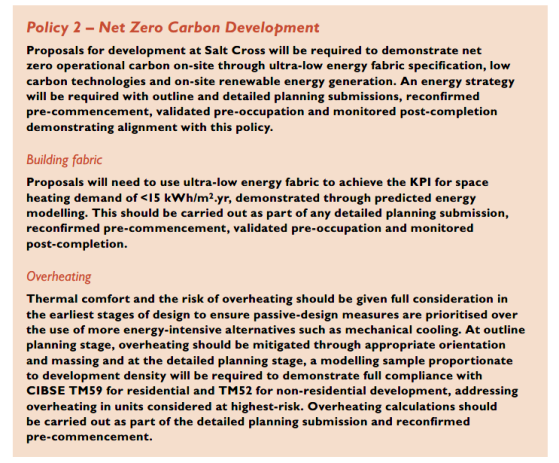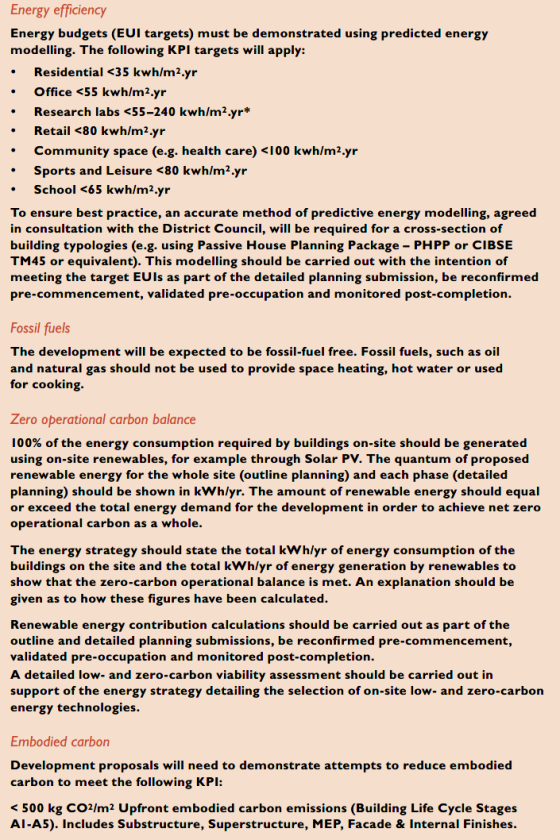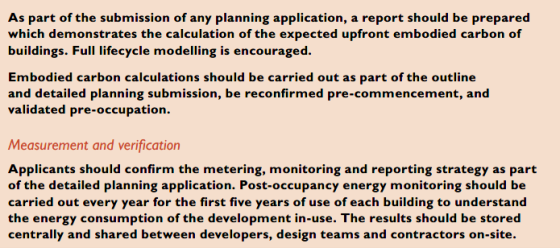Above and beyond
- Details
Can local plan policies require developers to go beyond national standards? Simon Ricketts analyses a recent Planning Court ruling.
The answer is already relatively clear in relation to biodiversity net gain, in that the Planning Practice Guidance (14 February 2024) says this:
“Plan-makers should not seek a higher percentage than the statutory objective of 10% biodiversity net gain, either on an area-wide basis or for specific allocations for development unless justified. To justify such policies they will need to be evidenced including as to local need for a higher percentage, local opportunities for a higher percentage and any impacts on viability for development. Consideration will also need to be given to how the policy will be implemented.” (Paragraph: 006 Reference ID: 74-006-20240214).
[This is of course not to say that developers cannot choose to commit to provide more biodiversity net gain than is required. If they so choose, the decision maker should give appropriate weight to that commitment – see NRS Saredon Aggregates Limited v Secretary of State (Eyre J, 16 November 2023).
But for a long time the answer has been less clear when it comes to whether local planning authorities can impose minimum energy efficiency standards which go beyond what is required by way of national policy or legislation and it is that lack of clarity which led to R (Rights Community Action) v Secretary of State (Lieven J, 20 February 2022). The case concerned a judicial review, brought by a national campaign group, of an inspectors’ report into the Salt Cross Garden Village Area Action Plan. Salt Cross is a project being promoted by Grosvenor Developments Limited to the north of the A40 near Eynsham, West Oxfordshire. The challenge was to the inspectors’ finding that the plan’s policy 2 (“net zero carbon development”) was unsound because it was inconsistent with national policy, which they interpreted as advising that policies should not be used to set conditions above the equivalent of level 4 of the Code for Sustainable Homes.
Policy 2 was certainly prescriptive:



The inspectors tested this policy against what they took to be the “extant expression of national policy”, namely a 2015 written ministerial statement. They stated:
“123. In relation to the building performance standards in Policy 2 as they would apply to dwellings, there is a question of whether the approach is consistent with national policy. The issue arises by virtue of Paragraph 154(b) of the NPPF and the need for local requirements for the sustainability of buildings to reflect the Government's policy for national technical standards.
124. Although various Government consultations linked to the Future Homes Standard have signalled potential ways forwards, the current national planning policy relating to the endorsement of energy efficiency standards exceeding the Building Regulations remains the Written Ministerial Statement (WMS) on Plan Making dated 25 March 2015. This is supported by the associated NPPG dated from 2019 which explains that the 2015 WMS sets out the Government's expectation that policies should not be used to set conditions on planning expectation that policies should not be used to set conditions on planning permissions with requirements above the equivalent of the energy requirement of Level 4 of the Code for Sustainable Homes (approximately 20% above the 2013 Building Regulations across the building mix). The 2015 WMS remains an extant expression of national policy.”
They considered “there are inconsistencies between the approach set out in Policy 2 of the AAP and the national policy position explained above relating to exceeding the Building Regulations. In light of our conclusions relating to whether the overall approach in Policy 2 is justified, we do not regard the requirements as reasonable”.
They also considered the requirements to be insufficiently flexible:
"137. The detailed requirements also do not reflect the evolving nature of zero carbon building policy, where standards inevitably will change in response to technological and market advancement and more stringent nationally set standards, including within the Building Regulations. Policy 2 contains little flexibility to allow for such changes, or indeed to respond to detailed master planning that will evolve over time. This brings into question whether the evidence that supports the standards justifies the approach as a sound one.
138. We appreciate that Policy 2 provides a high degree of certainty about the standards that will be applied over the lifetime of the development. However, even judged on a proportionate basis, the evidence that underpins the prescriptive requirements lacks the necessary depth and sense of realism to show that Policy 2 represents an appropriate strategy. As such, Policy 2 is not justified."
They recommended a modification that “substitutes the wording of Policy 2 to introduce the need for an ambitious approach to the use of renewable energy, sustainable design, construction methods and energy efficiency. This is to be assessed at the planning application stage in response to an energy statement. The modification sets out what should be included within an energy statement, including elements set out in the submitted policy but without the specific, stringent requirements which we have found are neither consistent with national policy nor justified.”
The 2015 written ministerial statement did indeed advise that local plan policies exceeding minimum energy efficiency standards should not go beyond level 4 of the Code for Sustainable Homes:
"For the specific issue of energy performance, local planning authorities will continue to be able to set and apply policies in their Local Plans which require compliance with energy performance standards that exceed the energy requirements of Building Regulations until commencement of amendments to the Planning and Energy Act 2008 in the Deregulation Bill. This is expected to happen alongside the introduction of zero carbon homes policy in late 2016. The Government has stated that, from then, the energy performance requirements in Building Regulations will be set at a level equivalent to the (outgoing) Code for Sustainable Homes Level 4. Until the amendment is commenced, we would expect local planning authorities to take this statement of the Government's intention into account in applying existing policies and not set conditions with requirements above a Code level 4 equivalent. This statement does not modify the National Planning Policy Framework policy allowing the connection of new housing development to low carbon infrastructure such as district heating networks." (key passage underlined).
You may remember the context of that statement. The non-statutory Code for Sustainable Homes was at that point being formally being withdrawn. But the amendments to the Planning and Energy Act that were referred to in the 2015 WMS were never brought into force and the Government stated in 2021 that this meant that “local planning authorities will retain powers to set local energy efficiency standards for new homes.” Energy standards were amended in 2021 in excess of level 4 of the Code for Sustainable Homes. The closest there then was to a clear statement of the Government’s position was its January 2022 response to a Select Committee report on local government and the path to net zero:
"The National Planning Policy Framework (NPPF) is clear that the planning system should support the transition to a low-carbon future in a changing climate, taking full account of flood risk and coastal change. It should help to shape places in ways that contribute to radical reductions in greenhouse gas emissions, minimise vulnerability and improve resilience; encourage the reuse of existing resources, including the conversion of existing buildings; and support renewable and low-carbon energy and associated infrastructure. The NPPF expects Local Plans to take account of climate change over the longer term; local authorities should adopt proactive strategies to reduce carbon emissions and recognise the objectives and provisions of the Climate Change Act 2008. Local authorities have the power to set local energy efficiency standards that go beyond the minimum standards set through the Building Regulations, through the Planning and Energy Act 2008. In January 2021, we clarified in the Future Homes Standard consultation response that in the immediate term we will not amend the Planning and Energy Act 2008, which means that local authorities still retain powers to set local energy efficiency standards that go beyond the minimum standards set through the Building Regulations. In addition, there are clear policies in the NPPF on climate change as set out above. The Framework does not set out an exhaustive list of the steps local authorities might take to meet the challenge of climate change and they can go beyond this." (key passages underlined)
Clear as mud!
Lieven J considered that the inspectors (perhaps unsurprisingly in the light of this confusion) had misunderstood what current Government policy was:
“The WMS has to be interpreted in accordance with the mischief it was seeking to address, and with an "updating construction", see by analogy with statute, Bennion on Statutory Construction (Eighth Edition) at Chapter 14. The WMS is not a statute but a policy, but even with a statute the mischief is a highly relevant consideration in interpretation, and the principle of applying an updating construction is well established. In order to make sense of the WMS in the circumstances that applied in 2023 it is essential to have regard to the fact that the restriction on setting conditions above Code Level 4, upon which the Inspectors relied in IR124, no longer apply.
In my view, the Inspectors' interpretation neither makes sense on the words, seen in their present context, or of the mischief to which it was applying. To interpret the WMS so as to prevent or restrict the ability of the LPA to set a standard higher than Level 4 is plainly wrong in the light of subsequent events. For this reason, the Inspectors erred in law in their approach by finding that Policy 2 of the AAP was inconsistent with the WMS.
I note that this analysis entirely accords with the position of the Government in its response to the Select Committee on Housing Communities and Local Government in January 2022, when it said: "Local authorities have the power to set local energy efficiency standards that go beyond the minimum standards set through the Building Regulations…." Therefore the Government itself did not appear to be suggesting that the policy in the WMS remains extant.”
The policy position has in fact moved on further since the inspectors reached their findings and is, I hope, now clearer:
Consultation closes on 7 March 2024 in relation to the Government’s current consultation on the Future Homes and Buildings standards to be delivered by way of changes to Part 6, Part L and Part F of the Building Regulations (12 December 2023)
In his accompanying written ministerial statement housing minister Lee Rowley says this about local authorities’ ability to set their own local energy efficiency standards:
““Since [the 2015 WMS], the introduction of the 2021 Part L uplift to the Building Regulations set national minimum energy efficiency standards that are higher than those referenced in the 2015 WMS rendering it effectively moot. A further change to energy efficiency building regulations is planned for 2025 meaning that homes built to that standard will be net zero ready and should need no significant work to ensure that they have zero carbon emissions as the grid continue to decarbonise. Compared to varied local standards, these nationally applied standards provide much-needed clarity and consistency for businesses, large and small, to invest and prepare to build net-zero ready homes.
The improvement in standards already in force, alongside the ones which are due in 2025, demonstrates the Government’s commitment to ensuring new properties have a much lower impact on the environment in the future. In this context, the Government does not expect plan-makers to set local energy efficiency standards for buildings that go beyond current or planned buildings regulations. The proliferation of multiple, local standards by local authority area can add further costs to building new homes by adding complexity and undermining economies of scale. Any planning policies that propose local energy efficiency standards for buildings that go beyond current or planned buildings regulation should be rejected at examination if they do not have a well-reasoned and robustly costed rationale that ensures:
- That development remains viable, and the impact on housing supply and affordability is considered in accordance with the National Planning Policy Framework.
- The additional requirement is expressed as a percentage uplift of a dwelling’s Target Emissions Rate (TER) calculated using a specified version of the Standard Assessment Procedure (SAP).
Where plan policies go beyond current or planned building regulations, those polices should be applied flexibly to decisions on planning applications and appeals where the applicant can demonstrate that meeting the higher standards is not technically feasible, in relation to the availability of appropriate local energy infrastructure (for example adequate existing and planned grid connections) and access to adequate supply chains.” (key passages underlined).
Isn’t all this where national development management policies would be particularly useful?
Simon Ricketts is a partner at Town Legal. This article first appeared on his Simonicity blog
Sponsored articles
Walker Morris supports Tower Hamlets Council in first known Remediation Contribution Order application issued by local authority
Unlocking legal talent
Lawyer (Planning and Regulatory)
Contracts Lawyer
Legal Director - Government and Public Sector
Locums
Poll








































